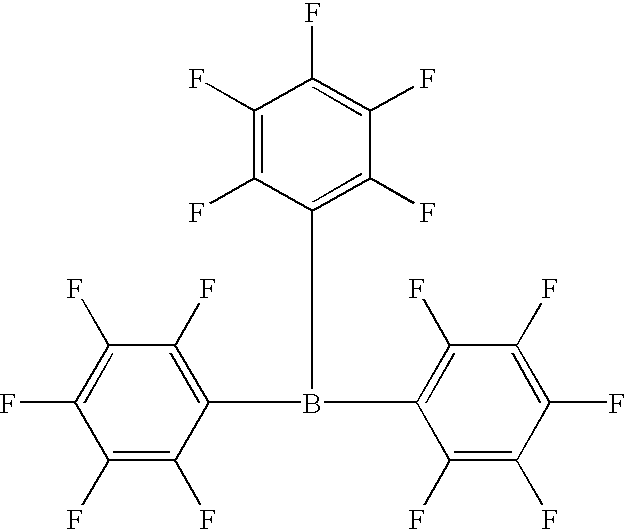Process for alkoxylation with a boron-containing catalyst
a technology of alkylene oxide and catalyst, which is applied in the field of alkoxylation with boron-containing catalyst, can solve the problems of unreacted alcohol in the product, unsatisfactory broad molecular weight product distribution, and odor problems of residual alcohol in the produ
- Summary
- Abstract
- Description
- Claims
- Application Information
AI Technical Summary
Benefits of technology
Problems solved by technology
Method used
Image
Examples
examples
[0030] Ethoxylates were prepared according to the process of the present invention via catalysis with tris(pentafluorophenyl)borane. The relative degrees of narrowing, residual starting material content, and by-product content were measured. The results were compared to ethoxylates prepared via conventional base catalysis.
[0031] The degree of narrowing was defined according to the following formula:
[0032] Degree of Narrowing: 1 Degree of Narrowing : D N = n = n max - 2 n = n max - 2 Y i
[0033] wherein n max=the molar number of added ethylene oxide (or alkylene oxide) in an adduct accounting for a maximum proportion by weight in a total adduct.
[0034] Yi=proportion by weight of an adduct having "i" moles of added ethylene oxide to a total weight of the adduct.
[0035] For degree of narrowing determination, the gas chromatographic (GC) area % was used. The degree of narrowing is expressed as a percentage (%). The higher the percentage, the narrower the molecular weight distribution. The f...
example 1
[0037] In this example, ethylene oxide was reacted with dodecanol on a 3:1 mole basis in the presence of a trispentafluorophenylboron catalyst. Dodecanol at 198.9 gm (1.08 moles) and trispentafluorophenylboron at 2.89.times.10.sup.-3 moles were charged to a two liter autoclave. The autoclave was then heated to 120.degree. C. with a nitrogen sparge. The autoclave was then vacuum stripped for one hour at 120.degree. C. with a slight nitrogen sparge. The autoclave was then heated to 150.degree. C. and pressurized to 20 psig with nitrogen blanket and 186.0 gm (4.22 moles) of ethylene oxide was added at 50 psig over a one hour period. The autoclave was then cooled to 120.degree. C. and vacuum stripped for ten (10) minutes, cooled and 370 gm of product discharged.
[0038] The product exhibited a higher degree of narrowing (82.5% versus 62.4%) and lower residual dodecanol content (2.9% versus 12.6%) than the Comparative Example. The product also exhibited a low by-product content, 0.03% diox...
example 2
[0039] Dodecanol (Aldrich) (197.6 gm (1.08 moles)) and Trispentafluorophenylboron at 0.264 mole percent were charged to a two liter autoclave. The autoclave was then heated to 120.degree. C. and purged one hour under vacuum with a nitrogen sparge. The autoclave was then cooled to 45.degree. C. and pressurized to 20 psig with nitrogen. Ethylene oxide (139 gm (3.22 moles)) was then added to the autoclave over a 21 / 2 hour period. Residual ethylene oxide was purged from the autoclave over a two (2) hour period to yield 318 gm of product.
[0040] The product exhibited a higher degree of narrowing (81% versus 62.4%) and lower residual dodecanol content (5% versus 12.6%) than the Comparative Example. The product also exhibited a low by-product content, 0.13% dioxane and 1.1% polyethylene glycol (PEG). The product was colorless.
PUM
| Property | Measurement | Unit |
|---|---|---|
| temperature | aaaaa | aaaaa |
| molecular weight distribution | aaaaa | aaaaa |
| molecular weight | aaaaa | aaaaa |
Abstract
Description
Claims
Application Information
 Login to View More
Login to View More - R&D
- Intellectual Property
- Life Sciences
- Materials
- Tech Scout
- Unparalleled Data Quality
- Higher Quality Content
- 60% Fewer Hallucinations
Browse by: Latest US Patents, China's latest patents, Technical Efficacy Thesaurus, Application Domain, Technology Topic, Popular Technical Reports.
© 2025 PatSnap. All rights reserved.Legal|Privacy policy|Modern Slavery Act Transparency Statement|Sitemap|About US| Contact US: help@patsnap.com


